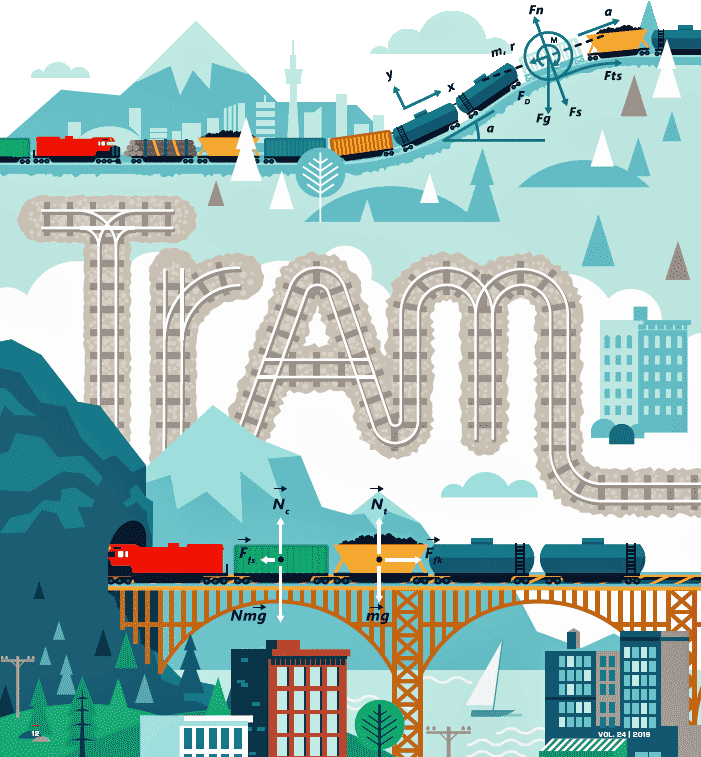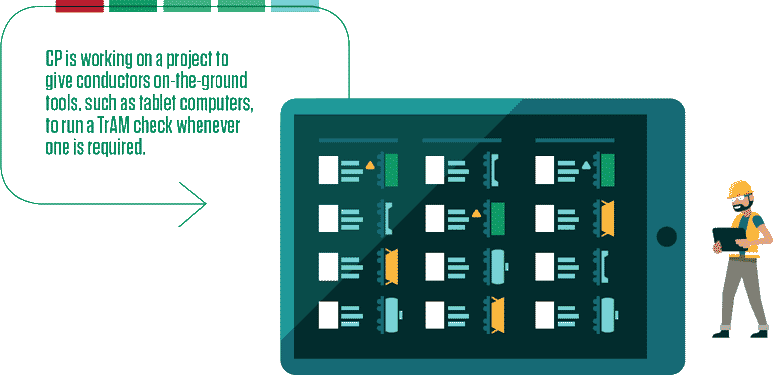

For 13 consecutive years, CP has led the industry with the lowest train accident frequency rate among Class 1 railroads in North America.
Many factors contribute to CP's safety success, among them, our industry-leading train area marshalling software, commonly known as Train Area
Marshalling (TrAM). TrAM is CP's system of train marshalling instructions that governs how to design or assemble a train to ensure its safe
operation over a given route or territory. Millions of lines of code seamlessly integrate data, such as tonnage, track curvature, grades, and the
force exerted by locomotives, and determines how to operate a particular train across a specific route. In this article, Canadian Pacific Magazine
examines the innovative computing power guiding our marshalling practices, which allow CP to run some of the most efficient and safest trains in the
industry.
On any given day, more than 250 trains operate across our 12,500 mile network. Primarily defined by its route, each train comprises a unique consist, the building blocks that piece it together, its DNA. Trains are a collection of empties and loads, a variety of car types, such as hoppers, gondolas, boxcars, and centre beams, all coupled together. Consists arrange sets of double-stacked containers and form trains stretching up to 16,000 feet (3.03 miles 4.9 kilometres) in length. Every day, trains link together thousands of rail cars with different weights, lengths, and dimensions throughout the system, with class codes guiding them safely to the next destination. Behind the scenes, running the math and ensuring each consist and associated train symbol arrives at its destination safely, is TrAM.
"Running trains is about respecting the laws of physics," said Brad Thiede, Director Operations Standards and Rules. "When building a train, you need to consider the territory, car type, car placement, locomotive placement, tonnage, curvature, and grades to reduce your risk profile. TrAM essentially takes care of the heavy lifting and calculates the risk profile for you."
When a terminal trainmaster enters a consist into the system, TrAM considers both the train and operating territory. Trains operating over specific TrAM areas have certain marshalling criteria that they have to meet. CP has five TrAM areas based on maximum grade and maximum curvature that trains will encounter on any given route. TrAM Area 1 encompasses our network's most straightforward terrain, with river grades and little to no curvature, and TrAM Area 5 addresses the most challenging and steep terrain, such as the Laggan and Mountain subdivisions in the Western corridor.
TrAM breaks things down further by train type. We run two types of trains at CP, bulk and manifest. With bulk trains, TrAM considers the total train length, how much distance is between the lead locomotive and remote locomotives, how much allowable tonnage can trail the locomotives, and allowable tonnage in front of the remote locomotives. Why are these considerations important? It all has to do with managing in-train forces.
Should a derailment occur based on how a train was built, it typically happens for one of two reasons. The first is referred to as stringlining and occurs when a train moves around a sharp curve with too much pulling force from the head end, which causes it to try and straighten out, lifting cars off the track and derailing. The second is jackknifing, which occurs when a train descending a grade has too much trailing tonnage that eventually causes cars to pile against each other. Applying TrAM marshalling rules significantly reduces these two types of derailments from occurring because the software calculates in-train forces for every consist and the specified TrAM Area the train will operate in.
"Thanks to TrAM, you don't need to be a physicist to build a train," said Thiede. "Imagine if a terminal trainmaster or the Operations Centre had to manually calculate in-train forces for every train build? With TrAM, they only need to know how to interpret the messages or alerts the system provides once they've entered the consist."
Building bulk trains is relatively straightforward. There is a set number of cars and locomotives to be placed evenly when building a train. The rules surrounding maximum allowable distance between locomotives ensures proper operation of the air brake system, the greater the distance between engines, the greater the risk for air brake leakage.
The second type of train build is manifest, which includes a variety of different cars and commodities and generally combines loads with empties. Manifest trains are seemingly the most challenging to build because of their associated TrAM restrictions, however, TrAM alerts operators when thresholds are exceeded, and when that happens, prevents a train from running. This ensures that our operating practices are well within acceptable limits and allows us to build trains with confidence because every TrAM rule is backed by the laws of math and physics.
"TrAM is about safety and managing in-train forces," said Kyle Mulligan, Chief Engineer. "It's perceived as a limiting feature but it's actually designed to enable us to do more than we thought we could. By looking at sequencing of cars, how many cushioned drawbar units you can have, and what TrAM area you are going over, and then running countless simulations to develop train marshalling rules, this all enables us to run longer trains while mitigating the risk of train accidents."
The benefit of TrAM is its ability to perform thousands of calculations and highlight when the risk profile of a train is unacceptable. Without this ability, other railways need to ensure supervisors and conductors take the extra time to adhere to general marshalling rules. This is a mannual process that is susceptible to human error and limits the ability to run longer trains.
"This gives us greater opportunities to block cars together when you consider the route of the train and customer locations," said Mulligan. "Other Class 1s use prohibitive manual rules. This traditional design adds switching and results in double handling of cars. With TrAM, you can block loads and empties together as long as you're mindful of the number of loads versus empties you are aligning and where the locomotives sit on the train."
Other Class 1 railroads take the operating profile of the most challenging part of their network and apply the same blanket operating practices to every train profile regardless of whether or not the train will travel through that area. CP introduced TrAM in 2004 to move away from this model and utilize our assets more efficiently.
"Our network is so diverse, it doesn't make sense to apply unilateral standards to every train profile," said Keith Shearer, Assistant Vice-President Safety and Sustainability. "So in addition to safety and reducing train accidents, we get the added benefit of also reducing costs and increasing productivity because we are building better, more efficient trains with TrAM."
TrAM is not static. There are rules continuously being added to balance operational flexibility, maintain safety, and increase productivity by lengthening trains. Our simulators also play a vital role. Every time there is an incident, we drill down, take what we learn and integrate it into the simulator's programming. Our recent learnings have allowed us to extend the length of potash trains from 170 to 205 cars and in certain areas, allow for 16,000 foot intermodal trains.
"TrAM is not meant to hinder productivity, it's meant to enhance it," said Mulligan. "It is a key factor for mitigating train accidents. If we switched TrAM off tomorrow, it's not a matter of if there is going to be a derailment, it's a matter of when."

Before a train can depart a terminal, it must be TrAM compliant. If the train has work to complete over-the-road, such as lifting bad orders, a TrAM check is redone with the assistance of our Operations Centre to ensure the train is still compliant. CP is working on a project to give conductors on-the-ground tools, such as tablet computers, to run a TrAM check whenever one is required. This will reduce the time required for a TrAM check and any rework when marshalling needs correction.
"By deploying these tablets we further mitigate risk by giving conductors the ability to do a TrAM check with the touch of a button," said Mulligan. "It will quickly tell them if they are compliant and can continue with their trip, or if re-marshalling is required."
We are also using wayside detectors to run TrAM checks over the road to validate that they are done when required. Every 20 miles, detectors pull the consists of passing trains, giving us an opportunity to understand the state of our network and how many trains require re-marshalling. The next step is developing a process to determine the appropriate course of action when violations are found.
"We are getting to the point where TrAM has its fixed set of rules with the ability to integrate data, tablets, and wayside detectors. We are running more automated TrAM checks and we will eventually be able to tell what a good train looks like versus a bad one," said Mulligan. "We can plug that into data mining and machine learning. For instance, say we run a train 1,000 times, and it derailed twice. What was unique about those two trains? What was similar among the 998? How do these similarities and differences compare to our rules? This is how we are evolving TrAM."
